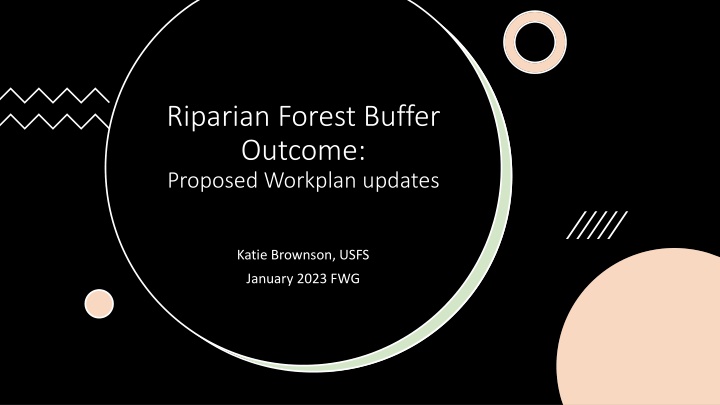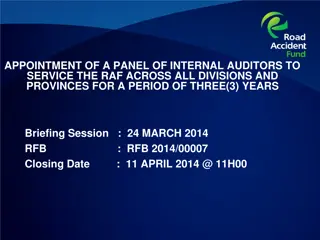
Enhancing Riparian Forest Management Strategies
This document outlines a proposed workplan for enhancing riparian forest management strategies, focusing on factors influencing success, current efforts, gaps, and proposed updates. It emphasizes the need for high-level coordination, improved technical assistance, staff capacity building, consistent implementation partners, and adequate funding. The workplan includes renewing leadership, improving existing programs, developing new ones, enhancing technical assistance, outreach, and communication, and utilizing new data and tools for better strategic planning and buffer delivery. The goal is to conserve existing buffers and ensure effective management approaches.
Download Presentation

Please find below an Image/Link to download the presentation.
The content on the website is provided AS IS for your information and personal use only. It may not be sold, licensed, or shared on other websites without obtaining consent from the author. If you encounter any issues during the download, it is possible that the publisher has removed the file from their server.
You are allowed to download the files provided on this website for personal or commercial use, subject to the condition that they are used lawfully. All files are the property of their respective owners.
The content on the website is provided AS IS for your information and personal use only. It may not be sold, licensed, or shared on other websites without obtaining consent from the author.
E N D
Presentation Transcript
Riparian Forest Buffer Outcome: Proposed Workplan updates Katie Brownson, USFS January 2023 FWG
Management Strategy- Longer-term (10 year) narrative document identifying factors influencing success, current efforts and gaps, management approaches, and strategies for monitoring and assessing progress (developed for 2015-2025) Logic & Action Plan Two-year workplan identifying specific actions that will be taken to implement the Management Strategy Strategic planning documents
Logic & Action Plan Components
Current Factors Influencing Success Need for high-level coordination and direction at state level Improved technical assistance Implementation partners need consistency, security, and cost- savings
Proposed updates to factors influencing success Leadership: Need for high-level coordination and direction at state level Improved technical assistance Capacity: Staff capacity for technical assistance and outreach; Contractor capacity for planting and maintenance Implementation partners need consistency, security, and cost-savings Funding: Availability of funding for flexible and effective buffer programs and to support capacity- building Policy: CREP provisions in new Farm Bill, state/local conservation policies to reduce RFB loss
1. Renew leadership 2. Improve existing programs and continue to develop new ones 3. Improve technical assistance 4. Improve RFB outreach and communications Current Management Approaches 5. Strategic planning and buffer delivery
1. Improve existing programs and continue to develop new ones 2. Support and develop effective buffer programs Improve technical assistance 3. Build capacity in staff, contractors and outreach 4. Improve RFB outreach and communications 5. Use new data and tools to improve strategic planning, buffer delivery, and reporting Renew and maintain leadership Proposed updates to Management Approaches Addition: 6. Conserve existing buffers
Management Approach 1: Renew and maintain leadership Regularly engage state and CBP leadership to support the implementation of state Riparian Forest Buffer Action Strategies and track progress New Actions
Management Approach 2: Support and develop effective buffer programs Build financial and human resources capacity to support the expansion of existing effective and flexible buffer programs Identify and communicate needed improvements to CREP under 2023 Farm Bill Support the development of new effective and flexible buffer programs to complement CREP where needed New Actions
Management Approach 3: Build capacity in staff, contractors and outreach Coordinate around regional training needs Identify opportunities to improve grant and funding provisions to better support building capacity in staff, contractors and outreach. Support workforce development in historically underserved communities New Actions
Management Approach 4: Improve RFB outreach and communications Update and maintain the Chesapeake Forest Buffer Network website as a resource for up-to-date information on buffer programs available in different states Develop a Chesapeake Forest Buffer newsletter to highlight examples of particularly effective programs or practices New Actions
Management Approach 5. Use new data and tools to improve strategic planning, buffer delivery, and reporting Evaluate opportunities to optimize RFB implementation for climate adaptation, resilience and equity Improve reporting and verification of forest buffers to ensure new buffers are getting full credit New Actions
Management Approach 6: Conserve existing buffers Identify policies or incentives that can be used to prioritize conservation and retention of existing forest buffers New Actions

